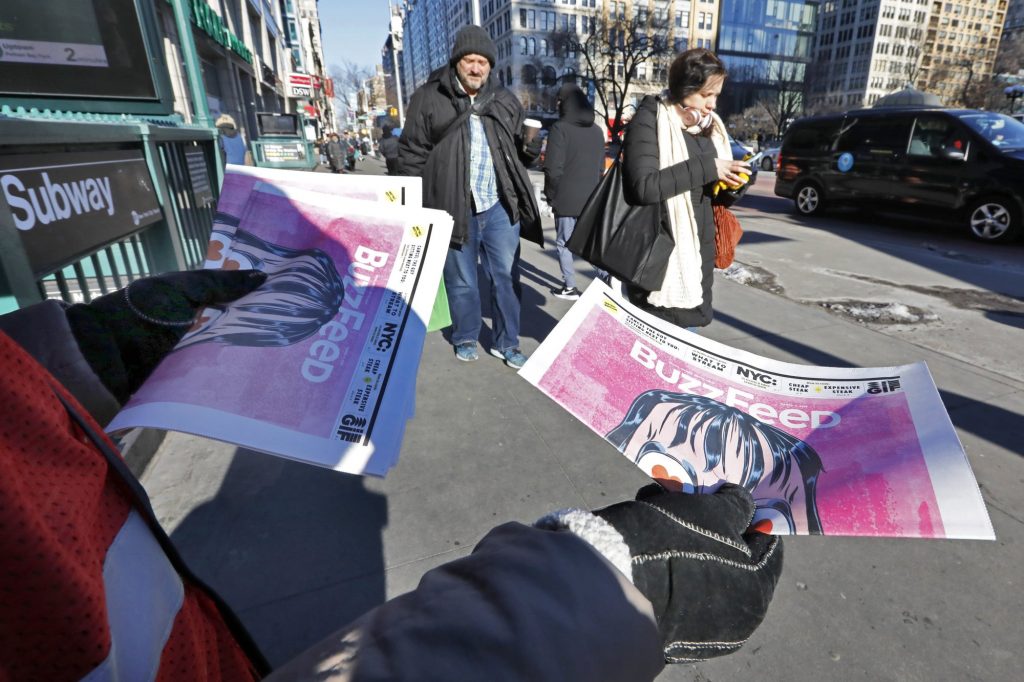The weather on March 6 in New York City was a blisteringly windy 26 degrees. For commuters coming out of the Union Square subway station, the last thing they expected was to be greeted by volunteers in Buzzfeed-branded gloves and hats handing out newspapers. Buzzfeed went physical.
From 5:30 a.m. to 1:30 p.m., “Buzzfeed Newsies” handed out almost 20,000 free copies of a 12-page newspaper in Union Square, Herald Square and Penn Station, three of the busiest subway stations in Manhattan.
The cover story was a piece about Momo, called, “How Momo Went From Viral Hoax to Viral Hottie.” The rest of the pages were filled with stories about how to cook steak, a feature on apple pie, and a GIF printed in five frames across the page.
“BuzzFeed was born on the Internet,” said Buzzfeed CMO Ben Kaufman in a given statement, “and we have a long history of doing unexpected things, so we had the fun idea to print out the Internet for a special one-time-only BuzzFeed newspaper. We thought it would be a fun way to start people’s morning commutes off right and spread some joy throughout New York.”
Since Buzzfeed’s inception in 2006, it made a name for itself as a place for celebrity news, personality quizzes and trendy listicles about the latest viral memes. Buzzfeed News was launched in 2011 as a serious journalism alternative side to Buzzfeed’s main brand of content. The setup worked well for the company for many years. Buzzfeed’s main branch would continue talking about the Kardashians and the meme of the week, all while using the profits of clickbait to subsidize the rest of their journalistic endeavors.
It’s easy to see such a company floundering. A 2014 survey from the Pew Research Center found Buzzfeed to be the most consistently distrusted news publication from a list of 36 outlets, ranking lower than Breitbart and The Drudge Report. It has consistently been plagued by accusations of plagiarism and publication of unsubstantiated claims. In 2018, Buzzfeed News tried to further distance itself from the Buzzfeed brand, moving from a News section tucked next to Videos and Quizzes to a dedicated website of their own. Between the backlash they’ve faced after laying off more than 15 percent of their staff without notice and having the only public comment made by the Muller investigation be to dispute one of their stories, Buzzfeed needed something good to happen.
The advent of social media has shaken traditional media to its core. Physical newspapers are on the decline. In a time where most publications are trying to pivot to video, why does a purely digital publication decide to go physical? The answer is simple. Buzzfeed needs some good PR. What better than a fun headline-catching story of a quirky newspaper to push recent headlines out of public consciousness?
The bizarreness of all this stands in stark contrast at the impact it made. The newspaper, much like the news they typically cover, amounted to nothing. It trended on Twitter for a couple hours and a few articles were written about it, but by the end of the day, it all but disappeared. Forgotten. Buzzfeed still has issues but now, at least, they have a physical one too.
Does this mean that people are finally done with Buzzfeed? Not likely. With followers in the millions throughout all their accounts across social media in a time where exposure is money, it doesn’t seem like the media juggernaut is going anywhere soon. If nothing else, hopefully, this will stand to other publications as an example of Top 5 Ways To Ruin Your Publication’s Reputation!
You can read the paper in pdf form here.




Comments are closed.